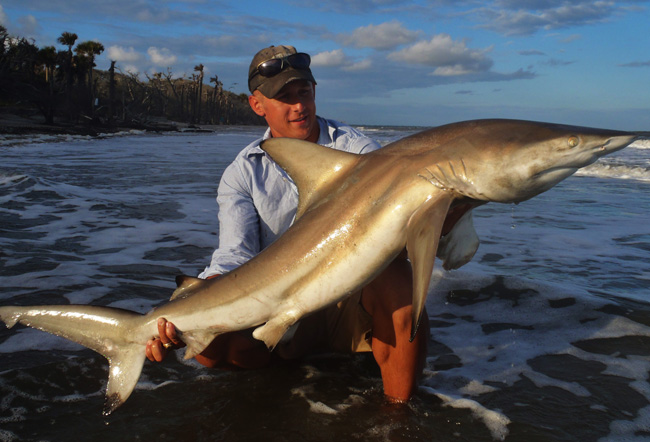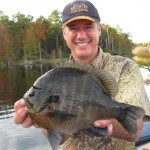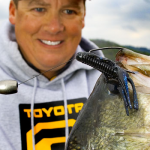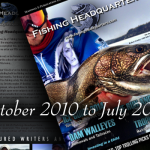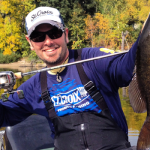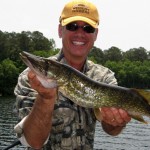By: David Graham – Date Posted: December 11, 2011
“SHARK”! Fewer words elicit more immediate, primal terror in person who hears it uttered. Throughout the vast animal kingdom, the shark most certainly invokes more mystery, fear and legend than any other creature. Arguably the single most feared predator on the planet, sharks are the ultimate carnivores, and have been for more than 400 million years. Their bodies are a weapon designer’s dream. Muscular and sleek, more streamlined than a stealth jet but deadlier than a nuclear submarine, sharks are built for speed and deadly accuracy. With heightened sensory organs capable of detecting drops of blood or distress movements long before their pray ever knew what was coming – along with the most notorious set of teeth in the world – predatory sharks are apex predators that reign supreme in the ocean.

Despite undeniable sporting qualities of the more common species, sharks tend to be largely ignored by sport fishermen, and are even regarded as something of a pest by others. Nevertheless, pursuing these fish with rod and reel is as exhilarating a fishing experience as one can find. Many anglers are either unequipped for, or uninterested in deep sea fishing voyages. However, the convenient, albeit frightening thing about sharks, is their propensity and proclivity to travel into very shallow waters, and in some cases, to freshwater in order to feed.
Many of us find the idea of wading into murky beach waters a chilling proposition, almost singularly inspired by Steven Spielberg’s 1975 classic film ‘Jaws’. This tale of man- eating great white sharks prowling populated stretches of beaches in pursuit of a human meal was transformative for many American vacationers. I would venture that most beach vacationers don’t enter the surf without at least a casual consideration of the possibility of an encounter with one of these toothy predators. For fishermen, though – the shark’s venture in to populated beach areas presents a unique opportunity for to challenge the undisputed heavyweight champion of marine predators from the comfort and safety of solid ground.

Fishing the Surf
Land-based shark fishing is a growing trend among both saltwater anglers and those who predominantly target freshwater fish alike. Despite the logical presumption that soaking a chunk of bloody fish inevitably brings bites, there are several tactics to consider when pursuing sharks from the shore.
Sharks prefer warm waters, but are ultimately driven to pursue their food source wherever it is located. Ideal ‘shark fishing’ water temperatures are anywhere between 65 to 75 degrees. During the spring and summer months, the most popular bait species populate the surf along with the predators that feed on them. In Southern Florida water temperatures rarely drop below 65 to 60 degrees, even during the winter months, making it prime shark-fishing territory during all seasons.
A 5-day weather assessment is also key in pre-planning a surf fishing trip. Weather-forecast variations notwithstanding, it is wise to constantly check the next day’s forecast until the final hours before departure for an angling trip. Ideal conditions for shark-fishing in the surf include winds between 5 to 10 miles per hour, or 3 to 5 foot seas. Winds beyond 10 to 15 miles per hour create difficult conditions to work with from the surf.
Tidal conditions are of key importance when surf-fishing; numerous online sources are available for tracking monthly tide forecasts. Tidal conditions will determine the movement of bait species being followed by sharks. Incoming tides will push bait species closer to the shore. This bodes well for shark anglers stocking up on bait or for those whose fishing equipment is better suited to fishing near the shore. Higher tides also allow larger predators to navigate across sand bars into deeper pools where smaller forage species congregate. During an outgoing tide, bait species are pushed away from shore and are naturally filtered through ‘washout points’ created by sandbars. Predator species like sharks will move away from the shore at this time to farther sand bars and washout points where the baitfish can be found.
A key tool for ‘reading’ surf is Google earth, or satellite images on basic Google maps. Google satellite images are perhaps a surf fisherman’s most convenient tool. These images enable an angler to locate jetties, sand bars, some depth variation, and access points. Understanding wave crests provide advantageous views of the location of sandbars, shelves and drop-offs.

Gear and Tackle
An angler hoping for any measurable success in hooking large sharks from the surf should expect to invest a considerable sum for appropriate tackle. Basic gear for medium sized sharks (small black tips, Atlantic sharp nose sharks, and small dogfish) doesn’t necessarily include a super heavy- duty rod and reel combination. For smaller sharks, large surf casting spinning rod and reel combinations will suffice. I predominantly fish Penn 850SSm spooled with 30-50 lb braid or monofilament line on a 12 foot ugly stick. This set-up is ideal for ‘short range’ surf fishing, but can also handle a medium-sized shark from up to 200 yards out.
For larger species such as big lemons, bull sharks, large black tips, etc., the Penn Senator series bait casters are nearly tailored for surf shark action. The Penn Senator can hold over 600 yards of 150lb braid. A 7-foot, 50-lb class rod works well with this rod and line combination. For larger shark rod and reel combinations, anglers should strongly consider wearing a ‘fighting belt’. These offer necessary comfort and leverage when working against strong fish from up to 400 yards out. The long, tedious process of ‘playing in’ a large shark can place tremendous strain on an angler’s back and arms if a fighting belt is not used. The fighting belt is designed such that the butt of the rod is ‘plugged’ in to the angler’s pelvis in a comfortable position, and helps balance the distribution of the anglers leverage and power with greater efficiency.
For both bait casting, and spinning rod and reel combinations, ‘rod spikes’ are necessary rod holding devices. These ‘spikes’ are available at most local bait stores in the vicinity of saltwater, but they are essentially nothing more than a 3 to 4 foot piece of PVC pipe sharpened at one end, and are an easy home-made tool. In order for rod spikes to work properly, they should be pushed firmly into the sand in the vertical position to prevent being pulled completely down by larger fish.

Bait Selection & Deployment
Despite the popular belief that sharks will mindlessly devour anything that bleeds or fits into their mouths, bait selection is of high priority to serious land-based shark anglers. I have always been a staunch believer that fresh bait is superior to rotting, stinking, foul bait – not just for shark fishing but for any type of bait fishing. Bait straight from the source is natural, and ideal. Shark bait can be collected in a variety of ways: cast net, local bait stores, freezer-stored bait, or fresh bait from rod and reel. Small whiting, ladyfish, pinfish, and other small species of fish can be caught and harvested on small chunks of calamari, worms, shrimp, or other fish bits on basic medium weight tackle. Anglers should, first and foremost, consider the food chain in the area where they will fish. Sharks always sit at the ‘top’ of the food chain, but different water variables can tremendously affect bait selection. For example, anglers fishing near jetties or rocky outcroppings should focus on using rock- dwelling fish as bait. Sheepshead is outstanding shark bait near rocks, and can be caught on clams, fiddler crabs, or other crustaceans. Anglers should consider state gamefish laws before using certain species for bait, but fish such as whiting, striped mullet, stingray, and ladyfish are good choices throughout all seasons.

Properly preserved reserve bait can be the difference between catching and not catching fish. Anglers should be aware that sharks will detect stationary bait by smell before all other modes of detection. Bait fish scents and natural oils can be lost if stored in a cooler of chlorinated ice water. Keeping each individual baitfish in sealed packages or zip lock bags under ice will keep bait fresh, and preserve the fish’s natural scent; this is key for attracting the shark’s keen sense of smell.
Bait deployment is another key factor in successful surf-fishing for shark. Observing and understanding wave crests is important for anglers in order to determine where sandbars begin and end. Anglers using long spinning rod-and-reel combinations will not always be able to launch baits beyond the last sandbar where the slope of the bottom resembles a staircase. Anglers casting into the surf should focus on areas with minimal wave action which indicates deeper water. Areas where relatively calm water is readily adjacent to a visible area of cresting waves are important as well. This indicates a point where a sandbar ends and tidal ‘pools’ feed into deeper waters. Predatory species will stage here for the natural filtration of bait species into and out of this funnel point during tidal movement.
More serious land-based shark anglers practice bait deployment by kayak. This is predominantly accomplished with larger bait-casting combinations which allows bait placement with the greatest range, up to 400+ yards from shore. A 6-to-10 foot sit on top kayak is great for paddling out without worrying about being flooded by the larger cresting waves. Anglers using this method of bait deployment should consider the lateral motion of tidal current. Placing baits into the current may be necessary to compensate for natural bait drag until the lead weight catches firmly into the bottom. With this method, the rod should be left in the rod spike with drag loosened enough that the bait can be towed out into the deeper waters without creating a great deal of resistance while paddling. The paddle out can be exhausting, but coming in is fun! Anglers considering this method of deployment should be confident in their kayaking skills, seas over 3 to 5 feet can be very intimidating and dangerous.
With multiple rod set-ups, anglers should separate rod spikes at a minimum of 20 yards between each rod. Sharks will make strong lateral runs parallel to the shore, making conflict with lines still in the water a real hazard. When using multiple rods placed with considerable spacing, it is wise to set a bait clicker and free spool, or loosen the drag enough to avoid the likelihood of rods being jerked free of your rod holders before you can reach them.
Shark Rigs
Without delving too deeply into numerous and complicated rigging schemes, anglers can enjoy a high hook up ratio with a basic Carolina rig. Anglers should first consider the susceptibility to cut, broken, or damaged lines when fighting in a shark. 120-300 pound steel cable leaders are imperative for medium to large shark species. Flexible, nylon coated steel leader wire is ideal for a good stealth to strength capacity. Anglers should consider that a shark’s teeth are designed for cutting, so they can and will bite through weaker lines or leaders. The length of the leader should be approximately the same length as the average size of the targeted species or more. If a shark turns in such a way that its own body length is longer than the leader, contact between the highly abrasive flesh of the sharks thrashing tail can wear down the lead line enough to cause breaks.
Leader sleeves and barrel swivels should reflect the weight capacity of the wire leader for which they are utilized. Circle hooks are ideal for sharks, since catch-and-release angler’s intent on retrieve their hooks should not attempt to delve too deeply into a shark’s throat – for obvious reasons. Circle hooks will always conveniently wind up in the corner of the shark’s mouth. I personally attach my circle hooks straight to the leader as opposed to a snap swivel to avoid swivels being forced open by sheer force. For anglers paddling baits far offshore, stout braided line may be a better choice than heavy monofilament line. Monofilament line will naturally stretch, and from up to 400 yards, this may hinder the circle hook’s ability to properly engage the fish when pressure is applied at the spool. Pyramid or spider weights should be attached indirectly to the lead line with the use of sinker sliders. Weights should reflect the strength of the tidal surge the angler chooses to fish. Particularly strong current may require up to a pound of led to keep a bait stationary.

The Fight
Anglers should understand that tidal movement and current can be valuable tools during the fight, but can also work against an angler if not properly played. Anglers should keep in mind that pressure should most often be applied in the opposite direction that the shark is running. Sharks will generally make lateral runs in a ‘zig zag’ manner parallel to the shore. Black tip sharks will often rocket out of the water and make a series of spectacular leaps upon the initial hook-up, anglers should be cautious of applying too much pressure initially. A shark’s initial run is like no other, and angler should endure the initial burst before applying a great deal of pressure on the fish. Once the shark begins to enter the cresting waves, or cross the sand bars, anglers should begin to use the momentum of the natural tidal push. Most pressure should be applied to the shark in its runs when surges of tide are already pushing the fish towards the bank. Once the fish is within range to be subdued, it is important that all necessary gear specific to landing and releasing a shark be in close, adjacent proximity. Landing gear may include a set of gloves, rope, long pliers, wire cutters, and bolt cutters.
There are three ‘most effective’ ways to land a shark. ‘Leadering’, if the leader is long enough, allows a a gloved-partner to drag the fish in by the leader. ‘Tail roping’ is essentially a ‘noose’, placed around the shark’s caudal fin, then pulling the fish in by the base of its tail from a safe distance; or by hand at the base of the tail. It is particularly dangerous to land a shark by its tail using only your hands! Even a very large shark can turn on its own body length to bite, and the powerful stroke of a shark’s abrasive tail can inflict lacerations.
Long pliers can work a circle hook out of a smaller shark’s toothy jaws, but even a small shark’s biting power should be duly respected. Many shark anglers bring a set of bolt cutters to simply snip the hook in half, extricate it from the shark’s mouth, and re-attach another hook later. Sharks will quickly fatigue out of the water, therefore anglers should work as quickly and safely as possible to return the fish if they intend to release it.
The shark’s reputation has been overwhelmingly affected by being represented in word and cinema as a malevolent, mysterious monster. It is not an overstatement that sharks may be the most reviled, persecuted creatures on the planet. There is a sense of reverence and awe, though, at catching and touching a large shark. Perhaps this is due to the chilling realization that this creature can, and has, killed and eaten human beings, although certainly not with malevolent intent. Sharks come in unimaginable shapes and sizes and, quite frankly, can be caught right out of our favorite swimming spots. The shark is a fascinating prospect for anglers who seek the thrill and excitement of catching a truly formidable and unique large fish.



